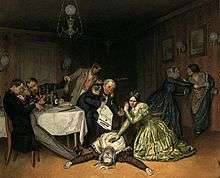1852–60 cholera pandemic

The third cholera pandemic (1852–60) was the third major outbreak of cholera originating in India in the nineteenth century that reached far beyond its borders. In Russia, more than one million people died of cholera. In 1853–54, the epidemic in London claimed over 10,000 lives, and there were 23,000 deaths for all of Great Britain. This pandemic was considered to have the highest fatalities of the 19th-century epidemics.[1]
Like the earlier pandemics, cholera spread from the Ganges delta of India. It had high fatalities among populations in Asia, Europe, Africa and North America. In 1854, which was considered the worst year, 23,000 people died in Great Britain.
That year, the British physician John Snow, who was working in a poor area of London, identified contaminated water as the means of transmission of the disease. After the 1854 Broad Street cholera outbreak he had mapped the cases of cholera in the Soho area in London, and noted a cluster of cases near a water pump in one neighborhood. To test his theory, he convinced officials to remove the pump handle, and the number of cholera cases in the area immediately declined. His breakthrough helped eventually bring the epidemic under control. Because of his insight and patient testing, he is considered the father of epidemiology.
See also
References
- ↑ "Cholera's seven pandemics". Canadian Broadcasting Corporation. Archived from the original on 16 December 2008.
